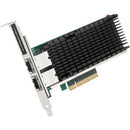Description
The SIIG Dual Port 10G Ethernet Network PCI Express Card is your gateway to unlocking maximum throughput in enterprise, server, and high-performance desktop environments. Built around the Intel X540-T2 chipset, this PCIe expansion card delivers two independent 10 Gigabit Ethernet ports, empowering you to consolidate workloads, accelerate data-intensive tasks, and scale network performance with ease. Whether you’re running virtualization, large backups, real-time analytics, or media-rich workloads, this PCIe card is engineered to provide reliable, enterprise-grade connectivity that adapts to your evolving network needs. With support for PCIe 2.1 specifications and x8 or larger slots, it fits seamlessly into a wide range of modern servers and workstations, offering the speed and flexibility you require without sacrificing system resources or reliability.
- Two independent 10G Ethernet ports: Experience blistering bandwidth with two dedicated 10 Gigabit interfaces that let you segregate traffic, run parallel workloads, and optimize performance for virtualized environments, high-speed backups, and large-scale file transfers. This dual-port design helps reduce bottlenecks by enabling simultaneous, isolated data paths, which is especially valuable for storage replication, live migrations, and multi-host workloads.
- Intel X540-T2 chipset for reliability: The included Intel X540-T2 processor offers proven performance, advanced offload capabilities, and strong compatibility with a broad ecosystem of NIC-enabled servers and network gear. Expect stable throughput, lower CPU overhead, and consistent latency management—benefits that translate to more predictable network behavior under load and simpler administration in complex environments.
- Flexible PCIe slot compatibility: This card installs in PCI Express slots that are PCIe 2.1 compliant with x8 or larger bandwidth, delivering scalable expansion without compromising motherboard resources. Its design supports a wide range of server and desktop configurations, enabling easy upgrades in data centers, labs, or growing workstations that demand high-speed connectivity.
- 10GBASE-T copper networking: The dual ports support 10GBASE-T copper Ethernet, allowing use of standard RJ-45 network cables. It also maintains compatibility with existing 1000BASE-T and 100BASE-T networks, enabling smooth integration into mixed environments and simplifying migration paths for evolving network infrastructures.
- Easy deployment and driver support: SIIG and Intel provide driver packages and utilities to configure link aggregation, VLANs, and performance tuning. The card is designed for straightforward installation, with resources available to help you optimize network settings, tailor traffic prioritization, and ensure dependable operation across supported operating systems and hypervisors.
Technical Details of SIIG Dual Port 10G Ethernet Network PCI Express
- Chipset: Intel X540-T2
- Ports: 2 x 10 Gigabit Ethernet (10GBASE-T)
- Interface: PCI Express 2.1 compliant, requires an x8 or larger slot
- Standards and compatibility: Supports 10GBASE-T copper cabling; backward compatible with 1000BASE-T and 100BASE-T networks; designed for enterprise-grade reliability in server and desktop deployments
- Form factor and installation: PCI Express expansion card suitable for standard PCIe slots in servers and desktops; straightforward insertion and secure mounting via a chassis screw for stability
- Driver and software support: Driver packages and utilities provided by Intel and SIIG for configuring dual ports, VLAN tagging, and traffic management; consult the vendor’s site for OS-specific compatibility and the latest updates
how to install SIIG Dual Port 10G Ethernet Network PCI Express
- Prepare your system: Power down the computer, unplug the power cord, and ground yourself to avoid static discharge. This helps protect sensitive components during installation.
- Open the chassis and locate a suitable PCIe slot: Find an available PCI Express slot that is PCIe 2.1 compliant and at least x8 in width. This ensures you have the required bandwidth to fully utilize both 10G ports.
- Install the card: Carefully align the card with the slot and press firmly to seat it. Once seated, use a screw to secure the bracket to the chassis for stability and proper cable management.
- Connect cables: Attach your two 10GBASE-T copper Ethernet cables to the RJ-45 ports on the card. Route cables neatly to switches, storage arrays, or other network devices as part of your planned topology.
- Install drivers and verify: Boot the system and install the latest drivers from Intel/SIIG. After installation, open your network settings to verify two active 10G interfaces. Run basic connectivity tests, and configure features such as VLANs or LACP as needed.
Frequently asked questions
- Q: What does this card provide? A: It adds two independent 10 Gigabit Ethernet ports to a PCIe-enabled server or desktop, enabling high-speed data transfers, virtualization, and robust network scalability with the Intel X540-T2 chipset.
- Q: What PCIe slot do I need? A: The card requires a PCI Express 2.1 compliant slot with a width of x8 or larger. A smaller slot (e.g., x4) may limit performance or may not support the card at all.
- Q: Is it compatible with my network cables? A: Yes. It uses 10GBASE-T copper Ethernet, so standard RJ-45 copper cables (Cat6a or better recommended for longer runs) work for 10G speeds. It also remains interoperable with legacy Ethernet speeds (1000BASE-T, 100BASE-T) on compatible networks.
- Q: Do I need special software or compensation for virtualization? A: The card is designed to work with virtualization platforms and supports features such as VLAN tagging and link aggregation through driver software. For the best results, install the latest drivers from Intel and SIIG and enable appropriate VMs/storage network configurations in your hypervisor.
- Q: Will this require extra power? A: No extra power connector is typically required. The card draws power from the PCIe slot, and standard server or desktop PSUs provide adequate power for normal operation in most configurations.
- Q: Where can I find drivers and documentation? A: Drivers and manuals are available from Intel and SIIG. Check the official product pages for the latest versions, OS compatibility, and configuration guides tailored to your environment.
Customer reviews
Showing - Of Reviews


